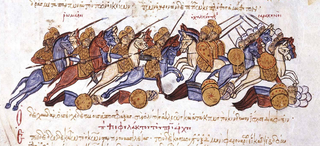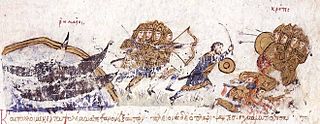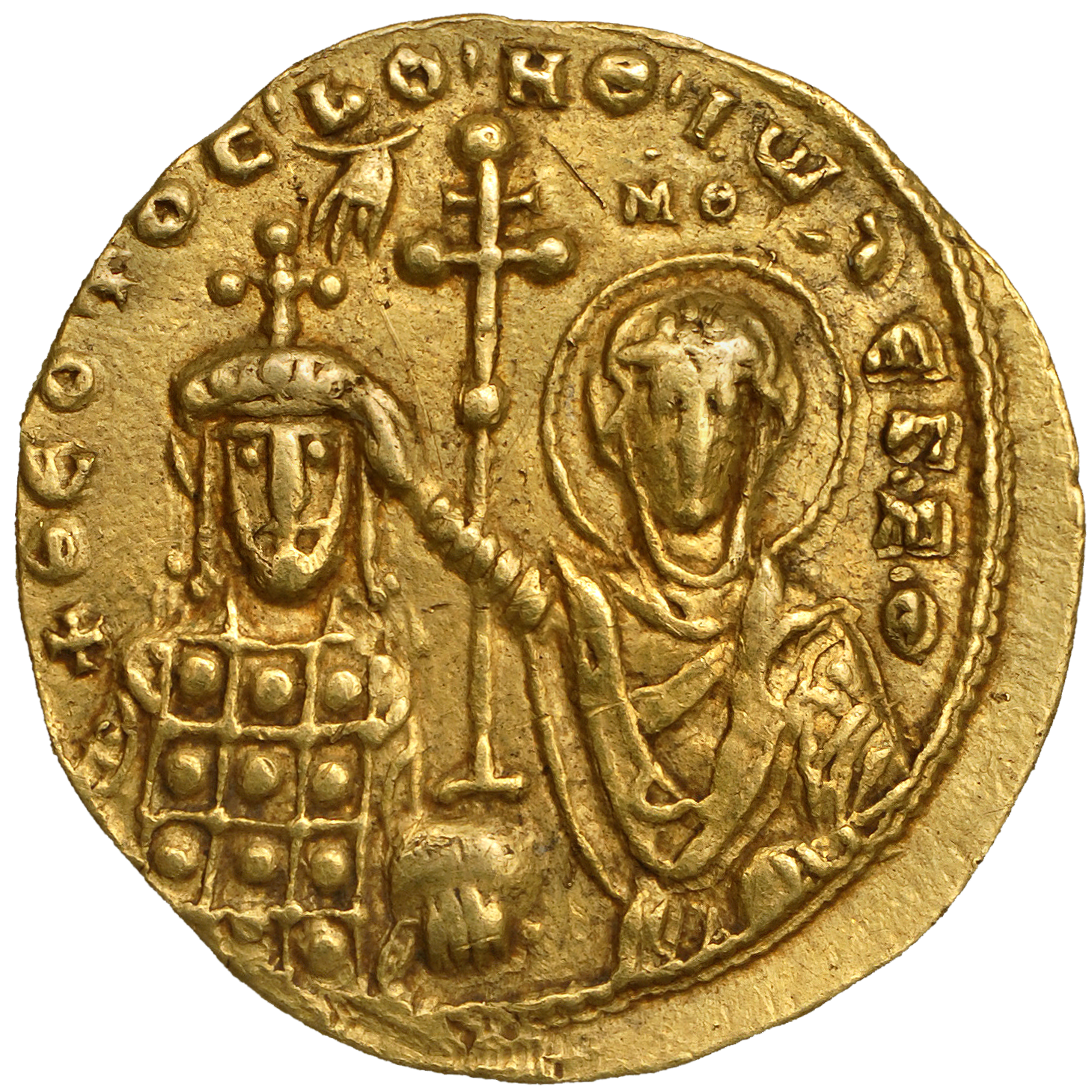 W
WPothos Argyros or Argyrus was a Byzantine commander, who served as the catepan of Italy during the eventful years of 1029 to 1031.
 W
WBasil I, called the Macedonian, was a Byzantine Emperor who reigned from 867 to 886. Born a simple peasant in the theme of Macedonia, he rose in the Imperial court. He entered into the service of Theophilitzes, a relative of Emperor Michael III, and was given a fortune by the wealthy Danielis. He gained the favour of Michael III, whose mistress he married on the emperor's orders, and was proclaimed co-emperor in 866. He ordered the assassination of Michael the next year. Despite his humble origins, he showed great ability in running the affairs of state. He was the founder of the Macedonian dynasty. He was succeeded upon his death by his son Leo VI.
 W
WBasil II Porphyrogenitus, nicknamed the Bulgar Slayer, was the senior Byzantine Emperor for almost 50 years, having been a junior colleague to other emperors since 960. He and his brother Constantine were named as co-rulers before their father Romanos II died in 963. The throne went to two generals, Nikephoros Phokas then John Tzimiskes, before Basil became senior emperor. His influential great-uncle Basil Lekapenos was the de facto ruler of the Byzantine Empire until 985. Basil II then held power for forty years.
 W
WThe patrikios Niketas Chalkoutzes was a Byzantine general, the first attested member of the Chalkoutzes family, and most notable for his recovery of Cyprus from the Arabs in 965.
 W
WConstantine IV, called the Younger and sometimes incorrectly Pogonatos out of confusion with his father, was Byzantine Emperor from 668 to 685. His reign saw the first serious check to nearly 50 years of uninterrupted Islamic expansion, while his calling of the Sixth Ecumenical Council saw the end of the monothelitism controversy in the Byzantine Empire; for this, he is venerated as a saint in the Eastern Orthodox Church, with his feast day on September 3.
 W
WConstantine V was Byzantine emperor from 741 to 775. His reign saw a consolidation of Byzantine security from external threats. As an able military leader, Constantine took advantage of civil war in the Muslim world to make limited offensives on the Arab frontier. With this eastern frontier secure, he undertook repeated campaigns against the Bulgars in the Balkans. His military activity, and policy of settling Christian populations from the Arab frontier in Thrace, made Byzantium's hold on its Balkan territories more secure.
 W
WConstantine Dalassenos was a prominent Byzantine aristocrat of the first half of the 11th century. An experienced and popular general, he came close to ascending the imperial throne by marriage to the porphyrogenita Empress Zoe in 1028. He accompanied the man Zoe did marry, Emperor Romanos III Argyros, on campaign and was blamed by some chroniclers for Romanos' humiliating defeat at the Battle of Azaz.
 W
WSaint Elias of Enna, born John Rachites, is venerated as a saint by the Catholic Church and the Orthodox Church. Elias is also known as Saint Elias the Younger, or Junior, to distinguish him from the biblical prophet Elijah. He lived a very adventurous life during the ninth century and was the protagonist of repeated ups and downs. He is commemorated on Aug. 17.
 W
WHeraclius was the Byzantine emperor from 610 to 641. His rise to power began in 608, when he and his father, Heraclius the Elder, the exarch of Africa, led a revolt against the unpopular usurper Phocas.
 W
WJustinian II, surnamed Rhinotmetos or Rhinotmetus, was the last Byzantine emperor of the Heraclian dynasty, reigning from 685 to 695 and again from 705 to 711. Like Justinian I, Justinian II was an ambitious and passionate ruler who was keen to restore the Roman Empire to its former glories, but he responded brutally to any opposition to his will and lacked the finesse of his father, Constantine IV. Consequently, he generated enormous opposition to his reign, resulting in his deposition in 695 in a popular uprising, and he only returned to the throne in 705 with the help of a Bulgar and Slav army. His second reign was even more despotic than the first, and it too saw his eventual overthrow in 711, abandoned by his army who turned on him before killing him.
 W
WJohn Kaminiates was a Greek resident of Thessalonica when the city, then one of the largest in the Byzantine Empire, was besieged and sacked by a Saracen force led by Leo of Tripoli in 904. His account of the city's plunder, On the capture of Thessalonica, survives in four manuscripts; though of these, none were written before the fourteenth century, causing some concern over the text's authenticity.
 W
WKrateros was a Byzantine naval commander in the 820s.
 W
WLeo III the Isaurian, also known as the Syrian, was Byzantine Emperor from 717 until his death in 741 and founder of the Isaurian dynasty. He put an end to the Twenty Years' Anarchy, a period of great instability in the Byzantine Empire between 695 and 717, marked by the rapid succession of several emperors to the throne. He also successfully defended the Empire against the invading Umayyads and forbade the veneration of icons.
 W
WLeo IV the Khazar was Byzantine emperor from 775 to 780 AD. He was born to Emperor Constantine V and Empress Tzitzak in 750. He was elevated to caesar the next year, in 751, and married to Irene of Athens in 768. When Constantine V died in September 775, while campaigning against the Bulgarians, Leo IV became senior emperor on 14 September 775. In 778 Leo raided Abbasid Syria, decisively defeating the Abbasid army outside of Germanicia. Leo died on 8 September 780, of tuberculosis. He was meant to be succeeded by his son Constantine VI, but rule instead transferred to his wife Irene, who assumed the role of regent and later empress.
 W
WGeorge Maniakes was a prominent general of the Byzantine Empire during the 11th century. He was the catepan of Italy in 1042. He is known as Gyrgir in Scandinavian sagas. He is popularly said to have been extremely tall and well built, almost a giant.
 W
WMichael III was Byzantine Emperor from 842 to 867. Michael III was the third and traditionally last member of the Amorian dynasty. He was given the disparaging epithet the Drunkard by the hostile historians of the succeeding Macedonian dynasty, but modern historical research has rehabilitated his reputation to some extent, demonstrating the vital role his reign played in the resurgence of Byzantine power in the 9th century.
 W
WNikephoros II Phokas, Latinized Nicephorus II Phocas, was Byzantine emperor from 963 to 969. His brilliant military exploits contributed to the resurgence of the Byzantine Empire during the 10th century. His reign, however, included controversy. In the west, he inflamed conflict with the Bulgarians and saw Sicily completely turn over to the Muslims, while he failed to make any serious gains in Italy following the incursions of Otto I. Meanwhile, in the east, he completed the conquest of Cilicia and even retook the islands of Crete and Cyprus, thus opening the path for subsequent Byzantine incursions reaching as far as Upper Mesopotamia and the Levant. His administrative policy was less successful, as in order to finance these wars he increased taxes both on the people and on the church, while maintaining unpopular theological positions and alienating many of his most powerful allies. These included his nephew John Tzimiskes, who would take the throne after killing Nikephoros in his sleep.
 W
WNiketas, possibly surnamed Abalantes, was a Byzantine military commander who in 964 led a major expedition against the Fatimid Caliphate in Sicily, was defeated, and spent a few years in captivity, where he copied the Codex Parisinus gr. 497 manuscript.
 W
WConstantine Phokas was a Byzantine aristocrat and general.
 W
WLeo Phokas or Phocas was a prominent Byzantine general who scored a number of successes in the eastern frontier in the mid-10th century alongside his older brother, the Emperor Nikephoros II Phokas. He served as chief minister during his brother's reign, but was dismissed and imprisoned by his successor, John Tzimiskes.
 W
WTheoktistos or Theoctistus was a leading Byzantine official during the second quarter of the 9th century and the de facto head of the regency for the underage emperor Michael III from 842 until his dismissal and murder in 855. A eunuch courtier, he assisted in the ascent of Michael II to the throne in 822, and was rewarded with the titles of patrikios and later magistros. He held the high posts of chartoularios tou kanikleiou and logothetēs tou dromou under Michael and his son Theophilos. After Theophilos' death in 842, Theoktistos became member of the regency council, but soon managed to sideline the other members and establish himself as the virtual ruler of the Empire. Noted for his administrative and political competence, Theoktistos played a major role in ending the Byzantine Iconoclasm, and fostered the ongoing renaissance in education within the Empire. He also continued the persecution of the Paulician sect, but had mixed success in the wars against the Arabs. When Michael III came of age in 855, his uncle Bardas persuaded him to throw off the tutelage of Theoktistos and his mother, the Empress-dowager Theodora, and on 20 November 855, Theoktistos was assassinated by Bardas and his followers.
 W
WTheophilos was the Byzantine Emperor from 829 until his death in 842. He was the second emperor of the Amorian dynasty and the last emperor to support iconoclasm. Theophilos personally led the armies in his long war against the Arabs, beginning in 831.
 W
WThomas the Slav was a 9th-century Byzantine military commander, most notable for leading a wide-scale revolt in 821–23 against Emperor Michael II the Amorian.
 W
WJohn I Tzimiskes was the senior Byzantine Emperor from 11 December 969 to 10 January 976. An intuitive and successful general, he strengthened the Empire and expanded its borders during his short reign.